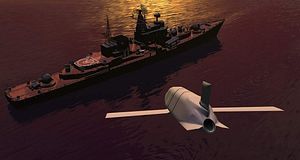Lockheed Martin conducted the second successful test of the new Long Range Anti-Ship Missile (LRASM) it is developing for the U.S. Navy and Air Force. The missile will be crucial in the U.S. military’s efforts to defeat Anti-Access/Area Denial (A2/AD) strategies, including China’s in the Asia-Pacific.
According to a press release published on Thursday, a U.S. Air Force B-1B bomber carrying the LRASM flew from Dyess Air Force Base in Texas to the Sea Range at Point Mugu, California where it “released the LRASM, which navigated through all planned waypoints receiving in-flight targeting updates from the Weapon Data Link. After transitioning to autonomous guidance, LRASM identified the target using inputs from the onboard sensors. The missile then descended for final approach, verified and impacted the target.”
The LRASM is a DARPA and U.S. Navy-funded program meant to provide the Navy and U.S. Air Force with an offensive anti-surface weapon (OASuW) to counter the growing threats from Anti-Access/Area Denial (A2/AD) doctrines. It is one of the major alternatives for the OASuW that is being considered.
Lockheed Martin has described the capabilities of the missile as: “The long range capability of LRASM will enable target engagement from well outside the range of direct counter-fire weapons. LRASM will also employ active and passive survivability features to penetrate advanced integrated air defense systems. The combination of range, survivability, and lethality ensures mission success.”
In light of the proliferation of cyber capabilities, Lockheed has placed a special premium on reducing the missile’s “dependence on ISR platforms, network links, and GPS navigation” in order to allow it to survive in “aggressive electronic warfare environments.” It will have air and surface-launched capability, travel at subsonic speeds, and carry a 1,000-pound penetrator and blast-fragmentation warhead.
Lockheed boasted in the press release that the LRASM leverages “a significant number of parts and assembly-process synergies” from its Joint Air-to-Surface Standoff Missile Extended Range (JASSM-ER) program. The LSRAM and the JASSM-ER are made on the same production line.
In 2009, Lockheed’s LRASM-A and the LRASM-B variants won a DARPA competition to fund what it hoped would be the U.S. Navy’s new air-and-sea launched long-range anti-surface missiles. Based on their success in Phase 1, in 2010 DARPA green lighted Phase-2 development of both the LRASM variants, although it later axed the LRASM-B, which was technically much more complicated, at least for the time being.
However, Lockheed used the cancellation of LRASM-B to begin investing independently of DARPA in a LRASM-A that can launched from its MK 41 Vertical Launching System. In September, Lockheed conducted a private test of the MK41 VLS’s ability to launch a LRASM Boosted Test Vehicle (BTV). It succeeded.
Under the DARPA contract, three air-launched tests of the LRASM are scheduled for 2013. The first air-launched test of the LRASM was announced by the company in early September. It was also successful. Next year the company is expected to conduct two ship-based tests of the missile.
The successes come at a critical time as the U.S. Navy’s long-range and anti-ship capabilities have waned. Rep. Randy Forbes (R-VA) warned about this in a wide-ranging and engaging interview with Real Clear Defense that was published this week.
“We are technically ‘out-sticked’ by Chinese anti-ship cruise missiles (ASCM) right now,” Forbes said when asked the capabilities by RCD’s Editor-in-Chief Dustin Walker. “The Navy’s own ASCM, the Harpoon, is an all-weather, over-the-horizon, anti-ship missile system. Sounds technical, but in fact it was designed in the 1970s and now does not have the range or survivability to operate against more sophisticated anti-surface threats we are seeing from the Chinese PLA Navy today…. My subcommittee is now playing a leading role in reviewing the range of options for a new Offensive Anti-Surface Weapon (OASuW).”
Here's a video from Lockheed:

































